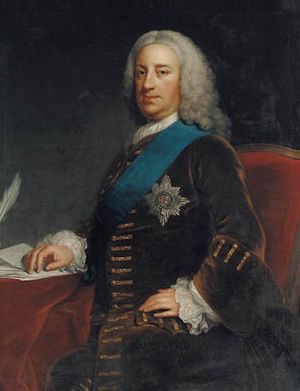William Cavendish, 3rd Duke of Devonshire facts for kids
Quick facts for kids
The Duke of Devonshire
|
|
|---|---|

William Cavendish, 3rd Duke of Devonshire
|
|
| Lord Lieutenant of Ireland | |
| In office 1737–1744 |
|
| Monarch | George II |
| Preceded by | The Duke of Dorset |
| Succeeded by | The Earl of Chesterfield |
| Lord Steward | |
| In office 1733–1737 |
|
| Monarch | George II |
| In office 1744–1749 |
|
| Monarch | George II |
| Lord Privy Seal | |
| In office 1731–1733 |
|
| Monarch | George II |
| Succeeded by | The Viscount Lonsdale |
| Personal details | |
| Born | 26 September 1698 |
| Died | 5 December 1755 |
| Nationality | British |
| Spouse | Catherine Hoskins |
| Children | 7 (including William Cavendish, 4th Duke of Devonshire, Lord John Cavendish, and Lord Frederick Cavendish) |
| Parents | William Cavendish, 2nd Duke of Devonshire Rachel Russell |
William Cavendish, the 3rd Duke of Devonshire, was an important British nobleman and politician. He was born on September 26, 1698, and passed away on December 5, 1755. He was a member of the Whig Party. He served in the House of Commons from 1721 until 1729. After his father's death, he became a Duke and joined the House of Lords.
Contents
Life of William Cavendish
William Cavendish was the son of William Cavendish, 2nd Duke of Devonshire. His mother was Rachel Russell. When he was young, he was known as the Marquess of Hartington.
Early Political Career
Like his father, William Cavendish was very involved in public life. He became a member of parliament (MP) for Lostwithiel in 1721. He was elected without anyone running against him. In 1722, he became the MP for Grampound. He was also unopposed when he became MP for Huntingdonshire in 1727.
In 1729, his father died, and William inherited the title of Duke. This meant he moved from the House of Commons to the House of Lords. In 1731, he became a Privy Counsellor. This is a group of advisors to the King. He also served as Lord Privy Seal from 1731 to 1733. This was an important government job. In 1733, he was made a Knight of the Garter. This is a very special award from the King. Later, he worked for seven years as the Lord Lieutenant of Ireland. This role meant he represented the King in Ireland.
Building and Charity Work
William Cavendish sold his old home, the Old Devonshire House, in London. In 1734, he hired a famous architect named William Kent. Kent built a new, grand home called Cavendish House in Piccadilly.
In 1739, the Duke helped start a new charity. It was called the Foundling Hospital in London. This hospital helped babies who had been left by mothers who couldn't care for them. It later became a famous place for art and music.
The Jacobite Rising
During the Jacobite rising of 1745, the Duke showed his loyalty to the King. He created a special army unit called the Derbyshire Blues. This group of soldiers gathered in Derby on December 3, 1745, to support the King.
Family Life and Children
On March 27, 1718, William Cavendish married Catherine Hoskins. She was born in 1700 and passed away in 1777.
The Duke and Duchess had seven children together:
- Lady Caroline Cavendish (born 1719 – died 1760). She married William Ponsonby, 2nd Earl of Bessborough. They had children.
- William Cavendish, 4th Duke of Devonshire (born 1720 – died 1764). He later became the next Duke.
- Lord George Augustus Cavendish (died 1794). He never married.
- Lady Elizabeth Cavendish (born before 1727 – died 1796). She married John Ponsonby and had children.
- Lady Rachel Cavendish (born 1727 – died 1805). She married Horatio Walpole, 1st Earl of Orford.
- Field Marshal Lord Frederick Cavendish (born around 1729 – died 1803). He was a high-ranking army officer and never married.
- Lord John Cavendish (born around 1734 – died 1796).

